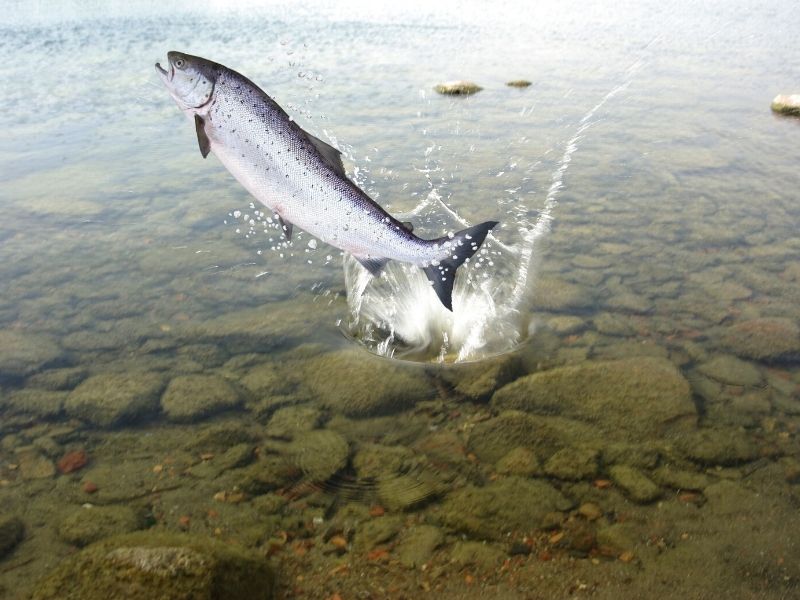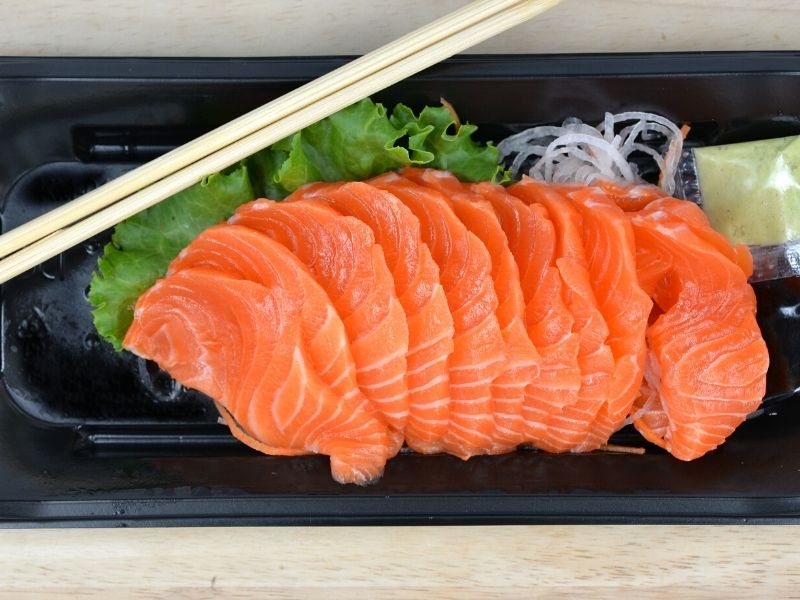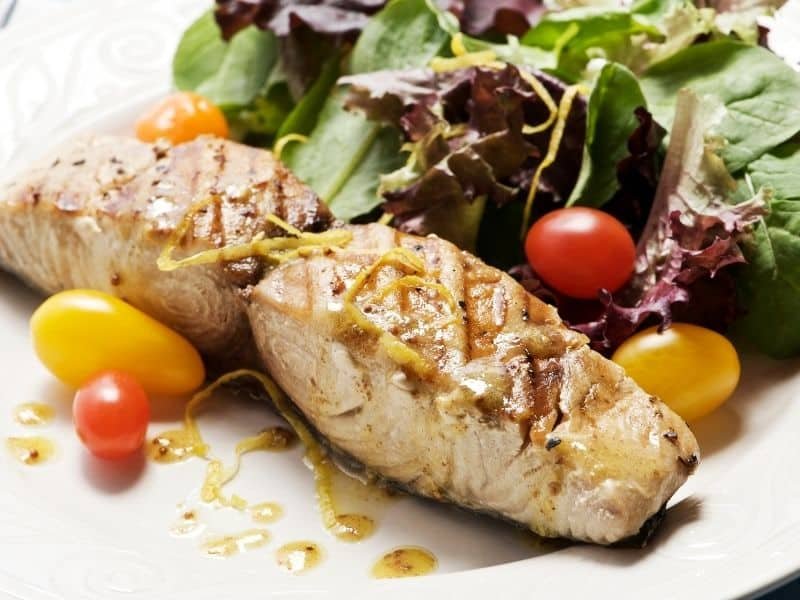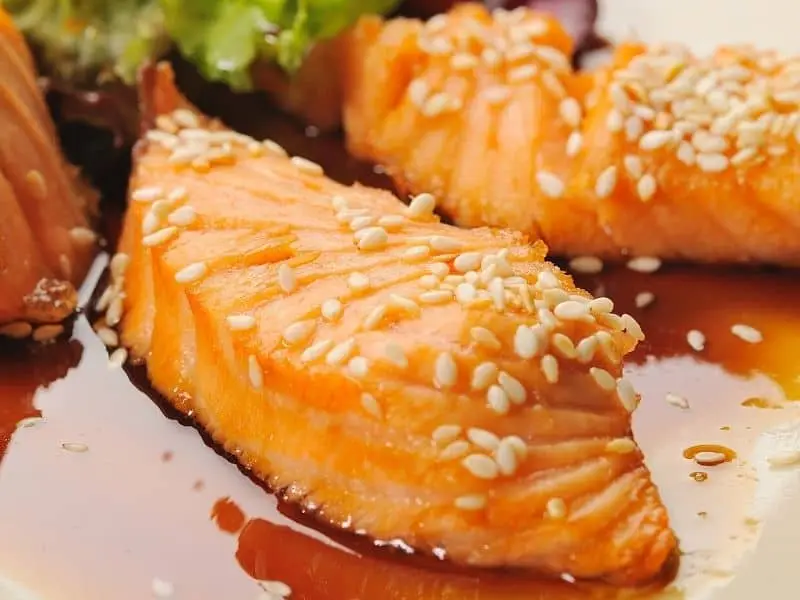Do you want to make sure your diet is nutritionally complete? Eating fish should be a priority if that’s the case. Salmon, in particular, could be especially beneficial – from its high levels of iron to essential fatty acids and more!
If you’re interested in this popular superfood, read more as we explore “Does Salmon Have Iron?”
So, does salmon have iron? Yes, fish is a reasonably good source of iron. In a 100-gram fillet, a woman receives enough iron to receive approximately 6% of her daily recommended amount.

This blog post will discuss the health benefits and why it is essential to include this fish in your diet.
About Salmon
It is a popular fish because it contains omega-three fatty acids and protein.
Omega-three fatty acids are beneficial for the heart and brain. They can also help to reduce inflammation in the body. Protein is essential for muscle growth and repair.
Types of salmon
There are three main types – Atlantic, Pacific, and chinook.
- Atlantic salmon is the most common type found in supermarkets. It is also the most farmed type.
- Pacific salmon is wild-caught and has a higher fat content than Atlantic ones.
- Chinook salmon, also known as king salmon, is the most significant type. It is also the most expensive.
- Coho salmon, Sockeye salmon, and Pink salmon are also types that are commonly consumed.

Does Salmon Have Iron?
Does salmon have high iron content?
Yes, it has a reasonably good source of iron, although it is not the highest compared to several other fish.
Iron is heme iron, an iron form that is readily absorbed. It contains greater amounts of iron than sources of non-heme iron like grains and legumes.
Furthermore, muscle meats absorb more iron from non-heme iron meals, which may help you absorb more.
The iron content
Chinook salmon, also known as King salmon or Alaskan salmon, is the largest and most valuable species of Pacific salmon in North America. It is healthiest when caught in the wild.
Here is the list of several types and their iron level per 100 grams servings:
- Chum salmon: 0.6 mg
- Atlantic salmon: 0.3 mg
- Chinook salmon: 0.9 mg
- Coho salmon, cooked: 0.4 mg
- Sockeye salmon: 0.5 mg
- Pink salmon: 0.5 mg
Sources include: USDA
Benefits of iron
Iron is an essential mineral that the body needs to function correctly.
- Iron is necessary to produce hemoglobin, which carries oxygen in the blood. It is also needed to produce myoglobin, a protein that helps muscle cells store oxygen.
- Iron is essential for energy metabolism and affects the immune system.
- A lack of iron can lead to anemia, a condition with insufficient red blood cells in the body. Anemia can cause fatigue, weakness, and pale skin. Severe anemia can be life-threatening.
- Pregnant women and young children are at a higher risk for iron-deficiency anemia because of their increased need for iron. The body needs more iron during periods of growth, such as infancy, childhood, and adolescence.
- Women of childbearing age are also at a higher risk for iron-deficiency anemia because they lose iron during menstruation.
How much iron do you need per day?
According to the National Institutes of Health (NIH), here’s how much-recommended intake of iron for different groups of people per day:
- Non-pregnant women aged 19 to 50: 18 milligrams of iron
- Pregnant Women: 27 mg
- Women, age 51 and older: 8 mg
- Men, age 19 and older: 8 mg
- Infants and children: 7 to 16 mg, depending on age
Around 20% of women, 50% of pregnant women, and 3% of men do not have enough iron in their bodies. In many situations, increasing iron intake is the answer.
You can get iron from food, supplements, or a combination. Good sources of iron include meat, poultry, fish, beans, lentils, spinach, and fortified foods.

What Fish Is High In Iron?
Fish with high iron content
Fish is a highly nutritious ingredient, and certain varieties, like tuna, are exceptionally high in iron.
A 3-ounce (85-gram) serving of canned tuna contains about 1.4 mg of iron, approximately 8% of the DV.
Besides tuna, mackerel, mahi-mahi, and sardines are a few other examples of iron-rich fish that you can also include in your diet.
Salmon vs. tuna
Tuna is the winner in minerals, containing higher magnesium, phosphorus, iron, selenium, choline, and manganese.
However, salmon is richer in calcium, potassium, and copper. Salmon is also a little higher in sodium.
Tuna and salmon have nearly equal amounts of zinc.
List of fish and its iron content
- Skipjack tuna: 1.6 mg
- Yellowfin tuna: 0.9 mg
- Haddock: 0.17 mg
- Mackarel: 1.4 mg
- Sardine: 2.92 mg
- Halibut: 0.66 mg
- Sea Bass: 0.88 mg
- Mahi Mahi: 1.1 mg
- Snapper: 0.2 mg
- Tilapia: 0.7 mg
- Swordfish: 0.5 mg
Sources include: USDA

List of Iron-Rich Food
What foods have the most iron?
Here are 12 healthy foods that are high in iron:
- Shellfish. Shellfish is especially rich in iron. Oysters, clams, and mussels contain the most iron per serving of any food. These shellfish are also high in zinc, copper, and selenium.
- Spinach. Raw spinach is a leafy green vegetable that is high in iron. It also contains magnesium, potassium, and calcium.
- Beef Liver. Beef liver is an excellent source of iron. It is also rich in vitamin A, vitamin B12, and copper.
- Red Meat. Red meat is a good source of iron. It is also rich in protein, B vitamins, and zinc.
- Cooked Lentils. Lentils are an excellent plant-based source of iron. They are also high in fiber, folate, and manganese.
- Tofu. Tofu is an excellent plant-based source of iron. It is also a good source of calcium and magnesium.
- Legumes. Legumes are an excellent plant-based source of iron. They are also high in fiber, folate, and potassium.
- Chickpeas. Chickpeas are an excellent plant-based source of iron. They are also high in fiber, magnesium, and phosphorus.
- Pumpkin seeds. Pumpkin seeds are an excellent plant-based source of iron. They are also a good source of magnesium, zinc, and copper.
- Quinoa. Quinoa is a grain that is high in iron. It is also a good source of magnesium, phosphorus, and copper.
- Turkey. Turkey is a good source of iron.
- Dark chocolate. Dark chocolate is a good source of iron. It also contains magnesium, copper, and manganese.
- Fish. Fish is a good source of iron. It is also a good source of protein, vitamin B12, and selenium.
How Your Body Uses Iron in Food
When you eat foods with iron, your body absorbs the iron into your bloodstream.
- Your age
- Your sex
- Whether you are pregnant or breastfeeding
- If you have any medical conditions that affect how your body absorbs iron
- The type of food you eat (for example, meat is a better source of iron than plants)
- How much iron do you have in your body (for example, people with low levels of iron absorb more iron from food than people with normal levels)
- How much non-heme iron is in the food (for example, cooked food has more non-heme iron than raw food)
- If you are taking any medications that affect how your body absorbs iron
Iron is also used to make myoglobin, a protein that helps your muscles store and use oxygen.
You can develop iron deficiency anemia if you don’t have enough iron. This is a condition where your blood does not have enough hemoglobin, so your body does not get enough oxygen.
Iron deficiency anemia can cause fatigue, pale skin, shortness of breath, and other symptoms. If you think you might have iron deficiency anemia, talk to your doctor.
Heme iron vs. Non-heme iron
- Heme iron, which makes up 40 percent of meat, poultry, and fish, is well absorbed.
- Non-heme iron, 60 percent of the iron in animal tissue, and all the iron in plants (fruits, vegetables, grains, nuts) is less well absorbed.
To improve the absorption of non-heme iron, consume foods rich in vitamin C simultaneously with foods containing non-heme iron.













